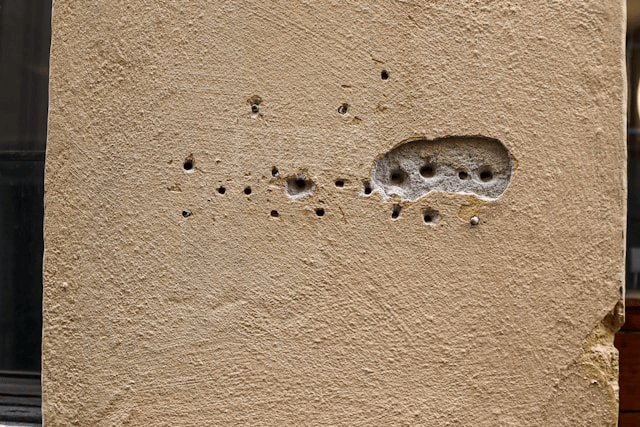Wall holes happen whether it’s from hanging pictures, moving furniture, or the occasional oops with a doorknob. But the good news is that repairing them doesn’t have to be a big project. In fact, with the right tools and a few simple steps, you can fix wall holes in minutes.
Whether you’re preparing to move out, sprucing up your home, or just tired of staring at that dent in the drywall, this guide will walk you through quick and easy drywall repair solutions that anyone can do even total beginners.
Common Causes of Wall Holes
Before jumping into the repair, it helps to understand what causes these annoyances in the first place. Here are the usual suspects:
-
Picture or shelf anchors
-
Nail or screw holes
-
Door handles hitting the wall
-
Accidental bumps and scrapes
-
Furniture moving accidents
-
Kids (enough said!)
Most of these leave behind small to medium holes that don’t require a professional fix. With a little effort, your wall can look good as new.
Types of Wall Holes
Not all wall damage is created equal. Knowing what kind of hole you’re dealing with helps determine the best fix.
-
Tiny nail holes – Left from framed photos or wall hooks
-
Screw or anchor holes – Slightly larger, often deeper
-
Medium-sized holes – From things like doorknobs or wall mounts
-
Large or structural holes – Usually best left to professionals
This article focuses on how to fix wall holes that are small to medium in size quick fixes that don’t require cutting drywall or complicated tools.
Materials You’ll Need
You don’t need a toolbox full of gadgets to start repairing your wall. Here’s what you’ll want to have on hand:
-
Spackle or lightweight wall filler
-
Putty knife or plastic scraper
-
Sandpaper (fine grit) or sanding sponge
-
Paint (matching your wall) and small brush or roller
-
Optional: wall repair patch (for medium holes)
-
Optional: primer (for stained or new repairs)
These supplies are inexpensive, easy to find at any hardware store, and last through multiple uses making them a great addition to any DIY toolkit.
Fix Nail Holes in Drywall (and Other Small Wall Holes)
Ready to patch things up? Here’s how to fix wall holes in minutes using spackle and a few simple tools.
Step 1: Clean the Area
Wipe the hole and surrounding area with a dry cloth to remove dust and debris. This helps the spackle stick better.
Step 2: Apply Spackle
Scoop a small amount of spackle with your putty knife and press it into the hole. Make sure it fills completely.
Step 3: Smooth It Out
Use the flat edge of the putty knife to smooth the surface. Scrape away any excess to create an even finish.
Step 4: Let It Dry
Let the spackle dry completely. Most quick-dry fillers only need about 15–30 minutes. Check the label for exact timing.
Step 5: Sand It Smooth
Once dry, gently sand the area until it’s flush with the wall. Use fine-grit sandpaper to avoid scratching the surface.
Step 6: Paint Over the Repair
Use a brush or roller to apply touch-up paint. If needed, apply primer first especially if the wall was stained or the hole was deep.
Done! You’ve just completed DIY wall repair that looks clean and professional.
For Medium-Sized Wall Holes: Use a Patch
If the hole is too large for just spackle, but still not big enough for major drywall work, an adhesive wall patch is your best friend.
How to Use a Wall Patch:
-
Place the mesh patch over the hole.
-
Apply spackle over the patch using a putty knife.
-
Feather the edges outward so it blends with the wall.
-
Let it dry, then sand and paint as usual.
These patches are especially helpful for holes from doorknobs or accidental impacts. They’re fast, strong, and designed to blend in with just a bit of sanding and painting.
Final Touches and Tips
Here are a few tips to make sure your drywall repair is smooth and long-lasting:
-
Match your paint carefully. Use leftover paint if possible or take a sample to the hardware store.
-
Use primer if you’re painting over spackle on a lighter-colored wall it helps prevent flash spots.
-
Avoid overfilling the hole with spackle. It’s easier to add more later than to sand down a huge bump.
-
Check your wall texture. If your wall is textured, use a texture spray or sponge technique after sanding.
With a little attention to detail, no one will ever notice there was a hole there.
When to Call a Pro
While you can patch wall holes in minutes if they’re small, some situations may call for expert help:
-
Holes larger than 4–6 inches wide
-
Damage near electrical wiring or plumbing
-
Signs of water damage, mold, or structural issues
-
Cracks that keep reappearing
If your repair seems more complex, it’s worth getting a professional opinion.
Conclusion
Now that you know how to fix wall holes, there’s no reason to live with unsightly dings and dents. With basic supplies and a few minutes of your time, you can handle drywall repair like a pro. Whether you’re dealing with small nail holes or slightly larger damage, these quick fixes are simple, affordable, and totally doable even for beginners.









